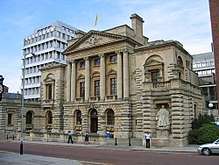George Skipper
George John Skipper (1856–1948) was a leading Norwich-based architect of the late Victorian and Edwardian period.[1] Writer and poet, John Betjeman said of him "he is altogether remarkable and original. He was to Norwich what Gaudi was to Barcelona"[2]
George Skipper | |
|---|---|
 Surrey House, Surrey Street, Norwich | |
| Born | George John Skipper 1856 |
| Died | 1948 |
| Nationality | English |
| Occupation | Architect |
| Practice | 7 London Street, Norwich |
| Projects | Jarrolds departmental store Royal Arcade Norwich Union headquarters |
Life
Skipper was born in the Norfolk market town of East Dereham, the son of Robert Skipper a carpenter and builder. Skipper was educated at the Bracondale School, Norwich and later went on to attend the Norwich School of Art for one year. He trained as an architect in London and returned to work in his father's firm of builders in Norwich. After setting up his own business in 1879 he was commissioned to design the town hall at Cromer and, subsequently, several seaside hotels in the town.[3]
Much of his best work, dating from around the beginning of the twentieth century, is in Norwich. At this time Skipper, along with his rival Edward Boardman dominated building in the city. His own office in London Street, now part of the Jarrolds departmental store, has a red brick facade, with a frieze featuring scenes of architects and builders. It is faced with a locally-made type of terracotta called Cosseyware, made at Costessey (pronounced "Cossey") near Norwich by the firm of Guntons.[4] In 1899 he designed the Arts and Crafts style Royal Arcade in the city.[5] His design for the Norwich Union headquarters in Surrey Street was completed in 1903–4. The building features the noted Marble Hall.[6]
Personal life
His first two wives died and he married again in 1913. His son, Edward (1918–2005) (by his 3rd wife Elizabeth Alice Charter, née Roberts), himself an important local architect, worked with him while studying architecture. Skipper died in 1948 and is buried in the Earlham Road Cemetery, Norwich.[7]
Works
- Norwich
- Jarrolds departmental store, Exchange Street and London Street. (1903–05).
- Skipper's office at 7, London Street now part of the above store (1896).
- Additions and extensions to 9–11 London Street (1897).
- The Royal Arcade (1898–99).
- Norfolk Daily Standard offices, St Giles' Street (1899–1900).
- Haymarket Chambers, (1901–03).
- Norwich Union, headquarters Surrey Street (1901–06).
- Commercial Chambers, Red Lion Street (1901–03).
- London and Provincial Bank (1907).
- Norfolk and London Accident Assurance offices, 41–43 St Giles' Street (1906), later a Telephone Exchange. Now (2010), a luxury hotel.[8]
- Cromer
- Cliftonville Hotel
- Cromer Town Hall (1890), Extant.
- Hotel de Paris. Extensively remodelled in 1895–96.
- Hotel Metropole, (1893). Demolished.
- Grand Hotel, (1891). Demolished.
- Sandcliff Hotel (1895)
- The Crescent - experimental council housing built with clay lump (1919-1920)[9]
- Sennowe Hall, was redesigned by Skipper between (1904–11).[10]
- Hunstanton Town Hall[11]
- Royal Norfolk and Suffolk Yacht Club clubhouse (1903)[12]
- Crispin Hall, Street (1885)
- Sexey's School, Bruton (1882-1891)
- Millfield School, Street (1888-1889)
References
- George Skipper Retrieved 8 March 2010
- Sir John Betjeman Retrieved 10 March 2010
- Evening News article Archived 18 January 2013 at the Wayback Machine Retrieved 12 December 2013
- "Cosseyware" (PDF). Archived from the original (PDF) on 4 October 2011. Retrieved 19 May 2010.
- Royal Arcade 8 March 2010
- "Surrey House". Eastern Daily Press. Archived from the original on 15 February 2010. Retrieved 8 March 2010.
- George Skipper information Retrieved 14 December 2015
- St Giles House hotel Archived 10 July 2011 at the Wayback Machine Retrieved 27 December 2010
- Retrieved 4 February 2018
- Sennowe Hall Archived 27 March 2010 at the Wayback Machine Retrieved 16 March 2010
- Hunstanton Town Hall Retrieved 13 March 2010
- Royal Norfolk and Suffolk yacht club Retrieved 22 March 2010
Further reading
- Summers, David (2009) "George John Skipper: Norfolk architect", in: Ferry, Kathryn, ed. Powerhouses of Provincial Architecture, 1837-1914. London: Victorian Society; pp. 74–82
External links
| Wikimedia Commons has media related to George Skipper. |